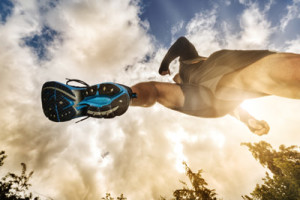 Running can be a healthy activity, but such a high-impact activity can have some drawbacks. Many runners complain of blisters on their feet that form whenever they run. These can be uncomfortable or even painful, and might even develop into a serious problem. However, there are a few things you can do to help prevent the formation of blisters, as well as some tips for treating blisters if they do form.
Running can be a healthy activity, but such a high-impact activity can have some drawbacks. Many runners complain of blisters on their feet that form whenever they run. These can be uncomfortable or even painful, and might even develop into a serious problem. However, there are a few things you can do to help prevent the formation of blisters, as well as some tips for treating blisters if they do form.
Blisters are the result of friction against the foot which causes the outer layers of skin to rub against each other and separate. Fluid then fills the gap, forming a blister. The area will become sensitive and sometimes painful, and there is a danger that the blister could become infected and fill with pus. If a blister ruptures, the danger of infection can rise, and untreated infections might lead to sepsis, when the infection enters the blood stream.
The best thing for your feet is to try and prevent blisters before they happen. This can be difficult as a runner, but there are a few things you can do to help reduce the chances of developing blisters. One of the most important things to do is make sure your shoes fit snugly on your feet and don’t move around too much. Any movement against your skin can cause a blister. Also, be sure to wear the right socks. Socks can keep moisture away from the skin and provide extra support. The key is to minimize friction against the skin, so applying bandages or tapes before putting on socks can help. Powders and creams can also help reduce friction.
If a blister does form, it’s not recommended to break it unless it’s extremely painful or somehow debilitating. Cover the blister with a bandage or gauze and let it heal on its own. If you absolutely have to break the blister, be sure it’s not infected first. If there are signs of an infection, such as pus or inflammation, call a doctor. If you absolutely have to break the blister on your own, wash it thoroughly and use a sterile needle to pierce the skin in a few places near the blister’s edge. Apply antibiotic ointment and keep your foot clean and keep an eye on it for developing infection. After 2-3 days, you should be able to cut away the dead skin. However, be very careful popping blisters, as infection is very dangerous and much more likely than if you don’t pop it.
Running is a great habit and helps your overall health, but it’s important to take care of your feet and try to prevent the formation of blisters. If you do get a blister, be sure to take care of it so that further problems don’t develop. Consult a doctor if the blisters become a problem. If you have any concerns about blisters or your feet and want to consult a podiatrist or other doctor, be sure to search IPALC at www.ipalc.org/find or email us any questions at info@ipalc.org.
Share on Facebook




 Southwest Florida Medicine.com is dedicated to bringing you the very best health information available today!
Subscribe or check back regularly!
Southwest Florida Medicine.com is dedicated to bringing you the very best health information available today!
Subscribe or check back regularly!